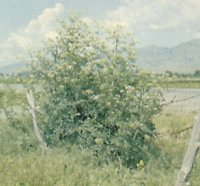POISON HEMLOCK



Description
Poison hemlock has white flowers that grown in small erect clusters. Each flower developes into a green, deeply ridgid fruit that contains several seeds. After maturity, the friut turns grayish brown.
Poison hemlock grows along fence lines, in irrigation ditches, and in other moist, waste places. It may be 4 to 10 feet tall. The hollow stem is usually marked with small purple spots. Leaves are delicate, like parsley. The white tap root resembles a large parsnip. Poison hemlock is a biennial in the parsnip or wild carrot family.

Poison hemlock is a range plant that kills many animals in the western United States. Sheep, cattle, horses, and other domestic animals are affected by eating a small amount. It is extremely poisonous to man.
Poison hemlock is sometimes confused with water hemlock-a more deadly species-because the names are similar. Poison hemlock has a number of common names. These include deadly hemlock, poison parsley, spotted hemlock, European hemlock, and California or Nebraska fern.
Roots of poison hemlock may easily be mistaken for wild parsnips
.
All parts of poison hemlock-leaves, stems, fruit and root-are dangerous. Leaves are especially poisonous in the spring, up to the time that hemlock flowers. Fresh leaves have a nauseating taste, so livestock seldom eat hemlock when other feed is available. The root becomes more toxic during the plant's first year of growth. The toxic substance is coniine, a volatile alkaloid.

Where and When It Grows
Because of its attractive flowers, poison hemlock was brought to the United States from Europe as a garden plant. It has become widespread on many ranges. It is found at roadsides, on edges of cultivated fields, in creek beds, in irrigation ditches, and in waste areas.
Poison hemlock starts growth in early spring. It usually grows for 2 years, but in favorable locations it may be a perennial.

How It Affects Livestock
Poison hemlock frequently is fatal. Sheep may be poisoned by eating as little as 4 to 8 ounces of green leaves. Cattle that eat 10 to 16 ounces may be affected.
Signs usually appear within an hour after an animal eats the plant. Animals die from respiratory paralysis in 2 to 3 hours. Convulsions, which are common in water hemlock poisoning, seldom occur with poison hemlock.

Signs of poisoning:
1. Nervous trembling
2. Salivation
3. Lack of coordination
4. Bloating
5. Dilation of the pupils
6. Rapid, weak pulse
7. Blue coloration of lining of mouth
8. Respiratory paralysis
9. Coma

HEMLOCK POISONING IN HUMANS
If a person is poisoned by hemlock, induce vomiting immediately. Call a physician.
To induce vomiting, give the victim a tablespoon of salt in a glass of warm water. Repeat treatment until vomit fluid is clear. Have victim lie down and keep warm and quiet until a physician arrives.
People may be poisoned by eating any part of a hemlock plant. Often, poisoning occurs after the victim confuses hemlock root with wild parsnips, hemlock leaves with parsley, or hemlock seeds with anise. Whistles made from hollow stems of poison hemlock have caused death in children.

BACK TO INDEX
H O M E
Would You Consider Signing
My Book?













